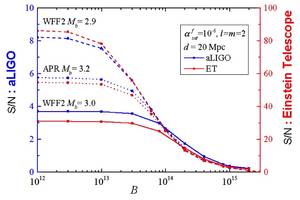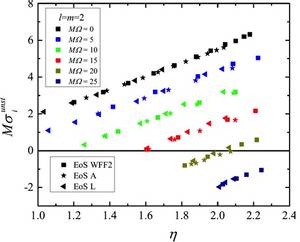Forschung 2015
Gravitational wave afterglow in binary neutron star mergers

October 2015
Daniela Doneva, Kostas D. Kokkotas, Pantelis Pnigouras
A very massive rapidly rotating star can be formed after binary neutron star merger. In the majority of the cases the star does not have a stable nonrotating limit and it collapses to a black hole after slowing down by a certain amount. Such neutron stars are one of the primary candidates to develop the secular Chandrasekhar-Friedman-Schutz instability, i.e. certain nonaxisymmetric modes of the star can become unstable due to the emission of gravitational waves that may eventually lead to strong gravitational wave signal.
In our studies we focused exactly on such objects and our goal was to check whether the emitted gravitational waves by secularly unstable oscillation modes shortly after the merger can be potentially observed by the next generation of detectors. The results show that indeed the produced gravitational wave signal can be very strong, reaching above the detector’s sensitivity, for moderate and even strong magnetic fields. The event rate will be of the same order as the merging rates, while the analysis of the signal will carry information for the equation of state of the post-merging neutron stars and the strength of the magnetic field.
Phys. Rev. D 92, 104040 (2015), arXiv:1510.00673 [gr-qc]
Asteroseismology of rapidly rotating neutron stars: An alternative approach
 July 2015
July 2015
Daniela D. Doneva, Kostas D. Kokkotas
One of the major challenges following the detection of gravitational waves from oscillating neutron stars is to infer its characteristic parameters like mass, radius and rotation rate via the observed data. For this purpose we should be equipped with a set of relations that connect the frequencies and the damping times of the oscillation modes to the stellar parameters. As a matter of fact this is the essence of the gravitational wave asteroseismology.
In our studies we focus on the fundamental f-modes of rapidly rotating neutron stars that are one of the promising sources of gravitational waves. An approach, different than the previous studies, is employed. First, the moment of inertia is used instead of the stellar radius and, second, the normalization of the oscillation frequencies and damping times is different. It is shown that in the nonrotating case this can lead to a much stronger equation of state independence. Our goal was to generalize the static relations to the rapidly rotating case and values of the spherical mode number l greater than 2. It turns out that this new set of asteroseismology relations we can be used to infer the stellar parameters from the observed gravitational wave signal with very good accuracy. The relations are also particularly useful for the massive rapidly rotating models that are subject to secular instabilities and thus can lead to copious emission of gravitational radiation.
Phys. Rev. D 92, 124004 (2015), arXiv:1507.06606 [astro-ph.SR]
